
| Genus List | Genus Overview | Species List |
5a. Tiny yellow species; completely eyeless; antenna with distinct 3-segmented club; mid tibia with several stout, peg-like setae; clypeus with anteromedian spine: JTL-006
5b. Larger brown to black species; single-faceted eye usually present; antenna with apical segments gradually enlarged, not forming distinct club; mid tibia lacking peg-like setae; clypeus with or without spine: 10

10a. Mandibles with teeth or denticles between the large basal tooth and the two large apical teeth: 20
10b. Mandibles with no teeth or denticles between the large basal tooth and the two large apical teeth: 30

20a. Anteromedian clypeal border with spine: pergandei
20b. Anteromedian clypeal border triangular: andersoni
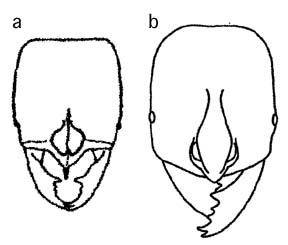
30a. Anteromedian clypeal border with spine: pergandei
30b. Anteromedian clypeal border lacking spine, triangular or bluntly rounded: 35
35a. Dorsal face of propodeum and petiolar dorsum sculptured, not smooth and shining: 40
35b. Dorsal face of propodeum and petiolar dorsum smooth and shining: JTL-005
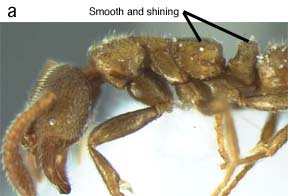
40a. Median clypeal projection narrowly and sharply triangular, projecting well beyond anterior clypeal border; head relatively long and narrow (head width/head length less than 0.80): 50
40b. Median clypeal projection rounded or broadly triangular, if triangular, projecting a short distance beyond anterior clypeal border; head relatively short and broad (head width/head length greater than 0.80): 70
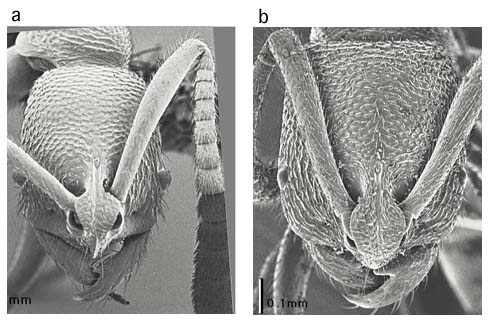
50b. Face transversely rugose: JTL-004
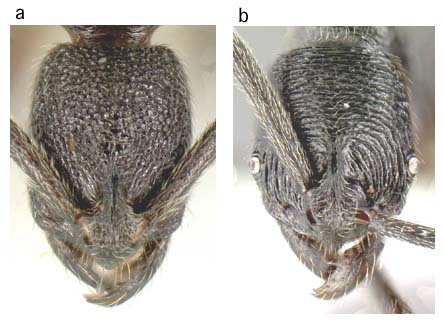
60a. Eyes relatively small: longinoda
60b. Eyes large: oculata

70a. Face sculpture vermiculate rugose; anterior clypeal projection broadly rounded and strongly projecting: paeminosa
70b. Face largely punctate; anterior clypeal projection rounded to broadly triangular, not strongly projecting: JTL-003
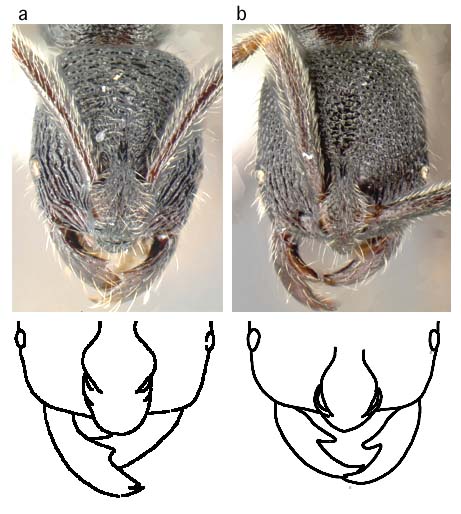
Key characters and variation
Mandible dentition: two strong apical teeth and one strong basal tooth are common to all. S. andersoni has highly variable dentition between the basal and subapical teeth: some have one additional strong tooth; some have two strong teeth; some have two or three small denticles; some have the basal tooth bicuspid (as though one of the denticles has moved down onto the basal tooth). pergandei is reported to have denticles between the basal and apical teeth, but the one specimen I have examined lacks them. The remaining species have no trace of teeth or denticles between the basal and apical teeth. JTL-003 has the basal tooth somewhat enlarged and blunt relative to S. longinoda, oculata, and paeminosa. paeminosa tends to have the basal tooth shifted apically relative to S. longinoda and oculata, and the tooth is shorter and relatively less acute. In JTL-003 and paeminosa the mandibles are relatively paddle-shaped, broadened medially; in S. longinoda and oculata the mandibles are sublinear.
Face sculpture: S. andersoni and JTL-004 have transversely arcuate rugae. oculata is relatively uniformly punctate in face view (in lateral view there is a distinct transition to sublinear, transversely arcuate rugae on the ventral surface of the head). S. longinoda has puncta and short transverse rugae. JTL-003 and JTL-005 have relatively large and confluent puncta, underlain by a granular microsculpture. paeminosa has coarse irregular rugae. pergandei is densely punctate.
Clypeal margin: pergandei has a spine on the anterior clypeal margin. S. andersoni, JTL-004, and oculata have a relatively acute clypeal margin. (A collection of S. andersoni from Osa Peninsula has clypeus relatively blunt, more like paeminosa.) S. paeminosa has a blunt, broadly rounded anterior margin. S. longinoda, JTL-003, and JTL-005 are intermediate.
Mesosoma sculpture: S. andersoni and JTL-004 are very distinctive, with widely-spaced sublinear striae. paeminosa is coarsely vermiculate rugose throughout, including the full extent of the lateral pronotum. S. longinoda, JTL-003, and oculata are intermediate and variable, with various combinations of vermiculate and sublinear rugae, and the ventrolateral region of the pronotum is often but not always smooth and shiny. JTL-005 has dorsal face of propodeum and petiolar dorsum smooth and shiny. S. pergandei is stated to be densely punctate (Wheeler 1935); the one specimen I have seen is weakly punctate.
Eye size:
Measurements: HW = head width, measured across widest portion of head above eyes, and not including eyes; HL = head length, midline length from anterior border of clypeus to posterior border of vertex; SL = scape length; WL = Weber's length. All measurements are mm. CI = HW/HL.
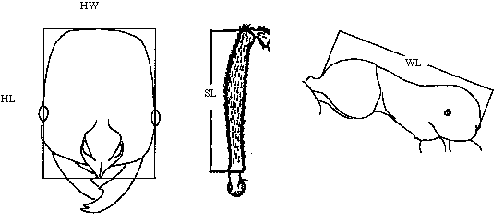
Species HL HW SL WL CI Barcode S. andersoni 0.881 0.716 0.869 1.396 0.81 INBIOCRI001279774 S. andersoni 0.937 0.720 0.979 1.506 0.77 INBIOCRI001279798 S. andersoni 0.967 0.768 0.962 1.521 0.79 INBIOCRI001279772 S. andersoni 0.971 0.766 1.004 1.544 0.79 INBIOCRI001279770 S. andersoni 0.973 0.765 0.965 1.525 0.79 INBIOCRI001279773 S. andersoni 0.982 0.768 0.975 1.526 0.78 INBIOCRI001279777 S. andersoni 0.991 0.797 0.924 1.535 0.80 INBIOCRI001279800 S. andersoni 1.022 0.800 0.993 1.560 0.78 INBIOCRI001279776 S. longinoda 0.709 0.533 0.527 0.75 JTLC000004642 S. longinoda 0.709 0.521 0.547 0.73 INBIOCRI001282646 S. longinoda 0.711 0.546 0.533 0.77 INB0003200214 S. longinoda 0.720 0.530 0.547 0.74 INBIOCRI001279780 S. longinoda 0.730 0.552 0.561 1.041 0.76 INBIOCRI001279781 S. longinoda 0.794 0.595 0.628 0.75 INB0003659275 S. longinoda 0.853 0.614 0.739 1.247 0.72 INBIOCRI001279786 S. longinoda 0.893 0.675 0.792 1.325 0.76 INBIOCRI001279785 S. longinoda 0.902 0.697 0.806 1.324 0.77 INBIOCRI001279783 S. longinoda 0.903 0.662 0.782 0.73 JTLC000006760 S. longinoda 0.905 0.675 0.779 1.294 0.75 INBIOCRI001279787 JTL-003 0.843 0.721 0.701 1.231 0.86 INBIOCRI001279802 JTL-003 0.847 0.726 0.739 1.251 0.86 INBIOCRI001279795 JTL-003 0.861 0.751 0.760 1.304 0.87 INBIOCRI001279779 oculata 0.895 0.615 0.796 1.319 0.69 INBIOCRI001279791 oculata 0.942 0.642 0.824 1.363 0.68 INBIOCRI001279801 oculata 1.013 0.728 0.948 1.558 0.72 INBIOCRI001279790 paeminosa 0.883 0.739 0.784 1.357 0.84 INBIOCRI001279792 paeminosa 0.899 0.739 0.790 1.372 0.82 INBIOCRI001279794
Page author:
John T. Longino, The Evergreen State College, Olympia WA 98505 USA.longinoj@evergreen.edu